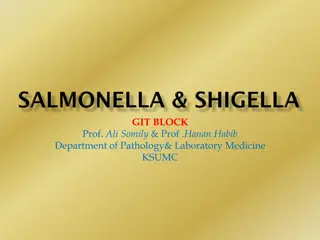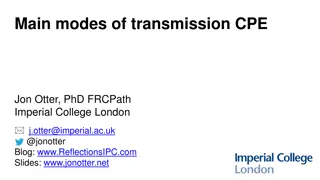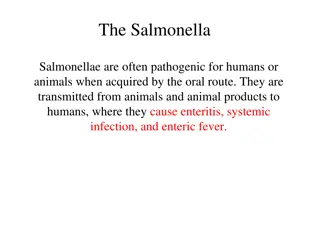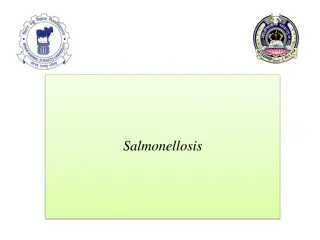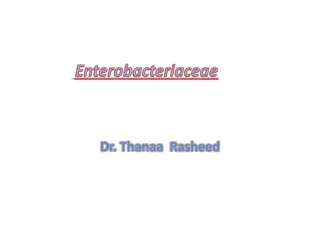Overview of Enterobacteriaceae Classification with Focus on Typhoidal Salmonella
Enterobacteriaceae is a bacterial family that includes Salmonella species. Typhoidal Salmonella, such as S. Typhi and S. Paratyphi, cause enteric fevers in human hosts. This user-friendly classification system categorizes Salmonella strains based on their clinical impact and host specificity.
Download Presentation

Please find below an Image/Link to download the presentation.
The content on the website is provided AS IS for your information and personal use only. It may not be sold, licensed, or shared on other websites without obtaining consent from the author. Download presentation by click this link. If you encounter any issues during the download, it is possible that the publisher has removed the file from their server.
E N D
Presentation Transcript
Enterobacteriaceae Salmonella
Classification Clinical Classification Oldest, user friendly classification widely used Typhoidal Salmonella: 1. Includes serotypes S. Typhi and S. Paratyphi Restricted to human hosts enteric fever (typhoid/paratyphoid fever) - - 2. Non-typhoidal Salmonella or NTS: Colonize intestine of animals - Also infect humans gastroenteritis & septicemia -
ANTIGENIC STRUCTURE Three important antigens on their cell wall 1. Somatic antigen (O) 2. Flagellar antigen (H) 3. Surface envelope antigen (Vi) found in some species - Fimbrial antigens - present in some strains - Nonspecific, widespread among other members of Enterobacteriaceae
O antigen H antigen Flagellar antigen Made up of proteins flagellin confers motility to the bacteria. Heat labile, Alcohol labile Formaldehyde stable In Widal test- H antigens of S.Typhi, S.Paratyphi A and B are used Features of O and H Antigen Somatic antigen Part of cell wall lipopolysaccharide (LPS) Heat stable , Alcohol stable Formaldehyde labile In Widal test- O antigen of S.Typhi is used O Ag is less immunogenic H Ag is more immunogenic
Features of O and H Antigen O antigen O antibody appears early, disappears early indicates recent infection When O antigen reacts with O antibody- forms compact, granular, chalky clumps Agglutination takes place slowly. Optimum temperature for agglutination is 550C H antigen H antibody appears late, disappears late- Indicates convalescent stage When H antigen reacts with H antibody- forms large, loose, fluffy clumps. Agglutination takes place rapidly. Optimum temperature for agglutination is 370C
Features of O and H Antigen O antigen H antigen Serogrouping is based on the O antigen Serogroups are differentiated into serotypes based on H antigen Flagellar antigens exist in two alternative phases Phase I and II. Most of them are biphasic except, (monophasic - S.Typhi) Also called Boivin antigen- extracted from bacterial cell by treatment with trichloracetic acid, first shown by Boivin
Vi Antigen Surface polysaccharide envelope or capsular antigen covering the O antigen Named with belief that Vi antigen is related to virulence Expressed in only few serotypes - S. Typhi, S.Paratyphi C, S. dublin and some stains of Citrobacter freundii (Ballerup-Bethesda group) Renders the bacilli inagglutinable with O antiserum agglutinable after boiling / heating at 100 C for 1 hour, which removes Vi antigen
Vi Antigen Poorly immunogenic & antibody titers are low Not helpful in diagnosis of cases Complete absence of Vi antibody poor prognosis Disappears early in convalescence. If persists carrier state Phage typing of S. Typhi - using Vi specific bacteriophages Vi antigens - used for vaccination
TYPHOIDAL SALMONELLA S. Typhi and S. Paratyphi A, B and C which cause enteric fever Pathogenesis Transmitted - feco oral Infective dose- Minimum 103 106bacilli Risk factors that promote transmission: Conditions that decrease: Stomach acidity (<1 year age, antacid ingestion, or achlorhydria or prior Helicobacter pylori infection) - Intestinal integrity (inflammatory bowel disease, prior GIT surgery or suppression of the intestinal flora by Antibiotics) -
Pathogenesis Entry through epithelial cells (M cells) lining the intestine - Bacteriamediated endocytosis (BME) - mediated by type III secretion system Entry into macrophages: Salmonellae containing vacuoles cross epithelial layer to reach submucosa phagocytosed by macrophages Survival inside macrophages: induces certain alterations on its surface insusceptible to the lysosomal enzymes
Pathogenesis Primary bacteremia: From inside macrophages spread via the lymphatics to enter the blood stream (transient primary bacteremia) Spread: Disseminate throughout reticuloendothelial tissues (liver, spleen, lymph nodes and bone marrow further multiplication Secondary bacteremia occurs from the seeded organs clinical disease
Clinical Manifestations Incubation period - 10 14 days Fever (step ladder pattern type of remittent fever): Other symptoms: Headache, chills, cough, sweating, myalgia and arthralgia Rashes (called rose spots): Faint, salmon-colored, blanching, maculopapular rash - trunk and chest (30%) Early intestinal manifestations - abdominal pain, nausea, vomiting and anorexia Important signs - hepatosplenomegaly, epistaxis and relative bradycardia
Clinical Manifestations Complications: Gastrointestinal bleeding and intestinal perforation in third and fourth weeks of illness Neurologic manifestations - Meningitis, cerebellar ataxia and neuropsychiatric symptoms ( muttering delirium or coma vigil ) - Paranoid psychosis, hysteria, delirium and aggressive behavior
Laboratory Diagnosis Duration of illness First week Culture of Blood, Bone marrow aspirate, Duodenal aspirate Second week and Third week Stool and urine culture Fourth week Stool and urine culture Carriers Stool and urine culture Serum- for detection of antibodies to Vi antigen Sewage culture- indirect way Specimen used and test done Serum- For antibody detection by Widal test For antigen detection
Laboratory Diagnosis - Culture and identification Blood Culture Sensitivity 90% in first week Clot culture: Blood is centrifuged serum for Widal test and clot for culture Culture medium: Conventional: Brain heart infusion broth, Castaneda s biphasic medium (BHI agar slope and BHI broth) - Automated blood culture systems - BACTEC orBacT/ALERT -
Isolation Sodium polyanethol sulfonate (SPS): Anticoagulant, Counteracts bactericidal action of blood Incubation: at 37 C for up to 1 week. Repeat subcultures: Monophasic BHI medium: Periodical subcultures onto blood agar and MacConkey agar Biphasic medium BHI is preferred over monophasic - subcultures in the same bottle Automated blood culture systems monitor growth continuously & positive growth flagged subcultures done
Isolation - Enrichment broth - Selenite F broth, tetrathionate broth and gram-negative broth are used Selective media such as: - Low selective media - MacConkey agar Colourless colonies
Isolation Highly selective media: DCA (deoxycholate citrate agar): pale colonies with black center - XLD agar (xylose lysine deoxycholate): red colonies with black center -
Isolation SS agar (shigella Salmonella agar): colorless with black centers Hektoen enteric agar: Bluegreen colonies with black centers Wilson Blair s brilliant green Bismuth sulfite medium jet black colored colonies with a metallic sheen due to production of H2S
Other Specimens Bone marrow culture - first week of illness (55 90% sensitive) when blood culture is negative, especially when patient is on antibiotics Duodenal aspirate culture - first week of illness if both blood and bone marrow cultures turn negative Combination of blood, bone marrow, and intestinal secretions culture is the best method in the first week, which shows a sensitivity of more than 90%
Identification Culture Smear and Motility Testing Gram-negative, non-sporing and non capsulated bacilli - Motile with peritrichous flagella - Biochemical Identification Catalase positive and oxidase negative - Indole test negative - Citrate test positive (except for S. Typhi and S. Paratyphi A, which are citrate negative) - Urease test negative -
Biochemical Identification Biochemical Identification of Salmonellae TSI shows: Alkaline/acid, Gas present (except for S. Typhi, which is anaerogenic), Abundant H2S present except for: - - S. Paratyphi A and S. Choleraesuis: H2S not produced - S. Typhi: Speck of H2S - MR positive and VP negative -
Biochemical Identification Sugar fermentation test: Gluocse, mannitol, arabinose, Maltose, dulcitol and sorbitol are fermented Decarboxylation test S. Typhi only lysine is decarboxylated - S. Paratyphi A only ornithine is decarboxylated - S. Paratyphi B positive for all, i.e. lysine, arginine and ornithine -
Demonstration of Serum Antibodies Widal Test Principle: Tube agglutination test where H and O antibodies against S. Typhi and S. Paratyphi A and B are detected Antigens used: Four antigens are used 1. O antigens of S. Typhi (TO) 2. H antigens of S. Typhi (TH) 3. H antigens of S. Paratyphi A (AH) 4. H antigens of S. Paratyphi B (BH)
Widal Test Procedure of Widal test: Patient s serum is serially diluted in normal saline in test tubes from 1 in 10 to 1 in 640 dilutions Four such sets are made To each set of diluted sera, respective four antigen suspensions (TO, TH, AH, BH) are added Control tubes containing the antigens and normal saline should be kept to check for autoagglutination Test tubes are incubated in water bath at 37 C overnight
Widal Test Results: O agglutination - compact granular chalky clumps (disk-like pattern), with clear supernatant Fluid H agglutination - loose fluffy cotton-woolly clumps, with clear supernatant fluid No agglutination - button formation & supernatant fluid remains hazy
Widal test result Suggestive of - Enteric fever due to S.Typhi Enteric fever due to S.Paratyphi A Enteric fever due to S.Paratyphi B Widal Test - Interpretation Rise of TO and TH antibody Rise of TO and AH antibody Rise of TO and BH antibody Rise of only TO antibody Recent infection -Due to any serotype -S.Typhi or S.Paratyphi A or B ? Convalescent stage/ Anamnestic response Post TAB vaccination Rise of only TH antibody Rise of all three TH, AH, BH antibodies-
Widal Test Titer: The highest dilution of sera, at which agglutination occurs Significant titer: In India H agglutinin titer more than 200 - O agglutinin titer more than 100 - Low titers should be ignored and considered as baseline titers in endemic areas
Widal Test False-positive: Anamnestic response: Transient rise of titer due to unrelated infections (malaria, dengue) in persons who have had prior enteric fever - Antigen suspensions are not free from fimbriae - Persons with inapparent infection - Persons with prior immunization (with TAB vaccine) - Fourfold rise in antibody titer demonstrated by testing paired sera at 1 week interval is more meaningful
Widal Test False-negative: Early stage (1st week of illness) & Late stage (after fourth week) - Carriers - Patients on antibiotics - Prozone phenomena (antibody excess) this can be obviated by serial dilution of sera - O agglutinins appear early and disappear early and indicate recent infection. H agglutinins appear late and disappear late -
Widal test O antibodies are serotype nonspecific. H antibodies are specific Other Antibody Detection Tests Typhidot test: OMP (outer membrane protein) antigen is used, detects both IgM and IgG antibodies - IDLTubex test: O9 antigen is used, detects only IgM antibodies against S. Typhi - IgM dip stick test and ELISA detect anti-LPS IgM antibodies - Dot blot assay: Flagellar antigen is used, detects only IgG antibodies -
Other Tests Demonstration of Salmonella Antigen - Present blood & urine - ELISA Molecular Methods PCR-based methods - detect and differentiate typhoidal salmonellae - flagellin gene, Iro B and fliC gene - Other Nonspecific Methods WBC count: Neutropenia (15 25%), Leukocytosis - children - Liver function tests moderately deranged - Muscle enzyme levels moderately elevated -
Detection of Carriers Culture: Stool and bile culture (detects fecal carriers) and urine culture (detects urinary carriers) Detection of Vi antibodies: - Tube agglutination test using S. Typhi suspension carrying Vi antigen (Bhatnagar strains) - Titer of 1:10 is also considered as significant Isolation of salmonellae from sewage: To trace the carriers in the communities - Sewer swab technique & Filtration
Typing of Salmonellae (Typhoidal and Non-typhoidal) For surveillance and determining the source of food-borne infections and outbreaks in hospitals Phenotypic methods: have low discriminatory power Phage typing is done for S. Typhi - Vi phage II. - Phage types most widespread and abundant throughout the world are E1 and A, followed by B2, C1, D1, and F1 Bacteriocin typing and biotyping Antibiogram typing
Typing of Salmonellae (Typhoidal and Non-typhoidal) Genotypic methods: They have good discriminating ability Insertion sequence (IS) 200 typing - Pulse field gel electrophoresis (PFGE) - Ribotyping - PCR-based methods: Random amplified polymorphic DNA typing (RAPD) and PCR-RFLP (Restriction fragment length polymorphism) - Sequence-based typing -
Prophylaxis Control of Reservoir Control of Cases Early diagnosis and prompt effective treatment - Disinfection of stool or urine soiled clothes with 5% cresol, 2% chlorine or by steam sterilizer - Follow up examination of stool and urine culture to detect carriers (twice, at 3 4 months and at 12 months) -
Prophylaxis Control of Carriers - Early detection of carriers by stool/urine culture or by detection of Vi antibodies - Effective treatment of carriers by: Ampicillin or amoxicillin (4 6 g/day) plus probenecid (2 g/day) for 6 weeks Surgery: Cholecystectomy plus ampicillin
Prophylaxis Sanitation measures - Protection and purification of drinking water supplies - Handwashing and improvement of basic sanitation - Promotion of food hygiene & Health education Vaccine - Provides short time protection, Indications - Travellers going to endemic areas, those attending melas and yatras - Household contacts & People at increased risk (school children)
Clinical Manifestations Gastroenteritis: most common - nausea, vomiting, watery diarrhea, fever and onset of abdominal cramps Bacteremia: Up to 8% of patients endovascular infection or seedling to various organs metastatic localized infection - Risk factors for bacteremia: NTS serotype: Most common - S. Choleraesuis & S. Dublin - Age: Infants and elderly people are at higher risk - HIV and other conditions with low immunity - Endovascular infections - endocarditis and arteritis
Metastatic localized infections : Intra-abdominal infections - hepatic or splenic abscesses or cholecystitis Meningitis (commonly in infants) Pulmonary infections - lobar pneumonia and lung abscess Pyelonephritis & cystitis Calculi & urinary tract abnormality Genital tract infections - ovarian, testicular abscesses, prostatitis and epididymitis Osteomyelitis: associated with sickle cell disease Reactive arthritis (Reiter s syndrome) - HLA-B27
References Textbook of Medical Microbiology by Ananthnarayan, Paniker Textbook of Medical Microbiology by C.P Baweja Textbook of Medical Microbiology by S. Bhat, A.S.Sastry Textbook of Medical Microbiology by D.R.Arora, Brij bala Arora







